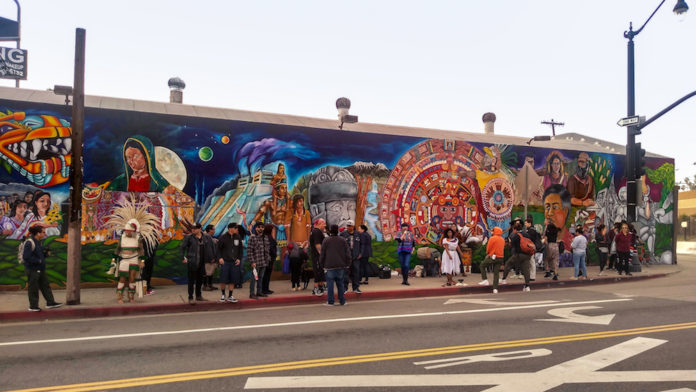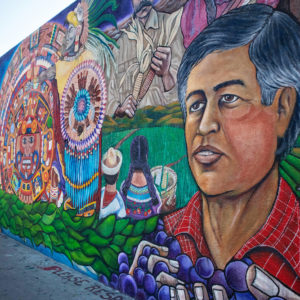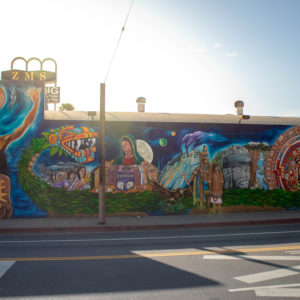
On the corner of North Avenue 61 and North Figueroa Street stands “Tenochtitlan — The Wall That Talks,” a 75-foot-long mural painted in 1996 by the Quetzalcoatl Mural Project (QMP). Following unexpected mural whitewashings in Highland Park in 2018, a rumored threat to the mural sparked controversy among Highland Park residents, according to Anthony “Eagle” Ortega, founder and director of QMP and one of the artists of “Tenochtitlan.”
“Tenochtitlan,” which features the designs and brushwork of at least ten muralists, is painted on the wall of 6039 North Figueroa St. in Highland Park. The building was purchased in August 2019 for $5.8 million by Fig Crossing, LLC, its current owner, according to Brenda Perez, founder of Restorative Justice for the Arts (RJFTA). Perez said she first learned about the mural’s potential erasure from John “Zender” Estrada, one of the artists of “Tenochtitlan.”
Estrada said he received a call in mid-January from Warren Brand, board member of the Mural Conservancy of Los Angeles (MCLA), a nonprofit founded in 1987 that advocates for the restoration, preservation and documentation of Los Angeles murals. According to Estrada, Brand said there was a possibility that the mural’s building would be sold and that its new owner might want to install windows in the mural wall. Estrada said this phone call was the only evidence he had to believe there was a threat to “Tenochtitlan,” and that neither he nor any other artists have had any contact with Fig Crossing, LLC. Brand did not respond to requests for comment.

After Perez was told about the phone call by Estrada, Perez and RJFTA hosted a mural blessing event Jan. 26 to raise community awareness about the alleged erasure. RJFTA raised $328 through a GoFundMe page to host the mural blessing. Estrada said he knew Perez had planned the event, but according to Ortega, neither himself nor any of the other artists were contacted about the potential threat, the mural blessing event or the fundraising effort. Ortega said he was concerned that Perez did not officially approach QMP before hosting the event.
Ortega said he first learned of the alleged threat to the mural after seeing social media posts advertising the RJFTA mural blessing event. He then communicated with City Council District 1‘s office to inquire about the threat. After these communications, City Council District 1’s office received a written statement from Fig Crossing, LLC, according to Ortega. Ortega said after the assurance from City Council District 1’s office and reading the statement, he had no reason to believe “Tenochtitlan” was ever at any risk.
Warren J. “Skip” Kessler, attorney for Fig Crossing, LLC, has since confirmed that the company has no plans to alter the mural.
“Our client, Fig Crossing, LLC, recognizes and understands the importance of the rich culture, history and heritage of the Highland Park neighborhood,” Kessler said via email. “Unfortunately, there have been several false and inflammatory statements recently surrounding our client’s ownership of this building and our client’s intentions regarding the Tenochtitlan Mural. Our client is very fond of the Tenochtitlan Mural and has no plans to erase, paint over, or alter the Mural or to demolish the wall.”
Ortega said he attended the mural blessing event with another “Tenochtitlan” artist, Andy Ledesma, in order to speak in front of the mural’s supporters and to confront Perez about worrying the community over nothing.
“Much of this confusion should have never surfaced,” Ortega said. “If [the destruction of “Tenochtitlan”] was a concern, this should have been brought to us, and we would have diligently handled the situation as a collective group of muralists.”
According to Perez, who has seen the statement issued by Fig Crossing, LLC, RJFTA still demands a legally binding document from Fig Crossing, LLC stating their intent not to erase the mural.
“Tenochtitlan,” which is registered with the LA Department of Cultural Affairs (DCA) as a Vintage Original Art Mural (VAM), is protected under the federal Visual Artists’ Rights Act (VARA), according to Perez and Ortega. Perez said that under these protections, all artists must be given a 90-day notice before a mural can be removed regardless of its registration status. According to Perez, individuals have ignored these protections in the past, such as in the whitewashing of the Migrant Farmworkers mural during Hispanic Heritage Month last year, and a legally binding document stating Fig Crossing, LLC’s intention not to erase “Tenochtitlan” would better protect the mural.

According to Ortega, the QMP plans to seek the support of the Highland Park Heritage Trust to protect and preserve “Tenochtitlan” as a historic landmark to ensure that the community never has to worry about the mural again. Ortega said residents who want to support mural preservation should consider donating to fund restorations and new projects.
“[Murals] are a major undertaking,” Ortega said. “To be frank, these public art projects need plenty of funding to continue the maintenance, the upkeep and the preservation efforts going on.”
Estrada said laws and protections are not very effective in actually preserving murals. Building owners will find loopholes in the Department of Community Affairs if there is any reason for complaints about a mural, according to Estrada.
“They’ll [whitewash] it in the night, you won’t see it coming, and then it’s too late,” Estrada said. “Ninety percent of mural protection is not cultural affairs.”
According to Estrada, the best protection for murals is support from communities, and people showing they care is the most effective way to prevent whitewashing.
![]()


































